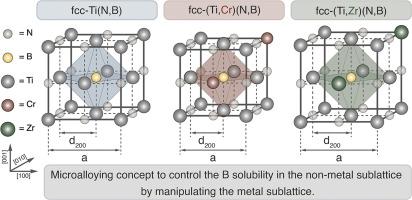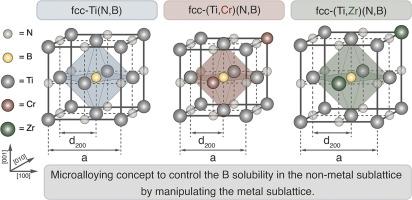Strategic lattice manipulation in transition metal nitrides for improved solubility
IF 8.3
1区 材料科学
Q1 MATERIALS SCIENCE, MULTIDISCIPLINARY
引用次数: 0
Abstract
In this study, we propose a new concept for achieving metastable ternary transition metal nitride solid solutions, focusing on face centered cubic (fcc) structured Ti(N,B) as a model system. Combining non-reactive magnetron sputtering with computational analysis, we develop a microalloying strategy to manipulate the metallic sublattice, thereby influencing the solubility of B in the non-metal sublattice. We show that imposed tensile strain on the fcc-TiN lattice facilitates the solubility of B, with a 1.5 % strain enabling the incorporation of ∼28.5 at.% B at the non-metal sublattice. Conversely, compressive strain hinders the formation of the fcc-Ti(N,B) solid solution, highlighting the importance of lattice manipulation in controlling solubility. At the same time, our experimental findings reveal that adding larger atoms, such as Zr, to the metal sublattice enhances the solubility of B in fcc-TiN more effectively (∼2 at.% Zr proves to be sufficient to solute 10 at.% B in the fcc-TiN lattice) than smaller atoms, like Cr or similar-sized Ti atoms. The size effect of the alloying atoms on the B solubility is further supported by radial distribution function analysis, showing lower local lattice distortions for Zr compared to Cr.


在过渡金属氮化物中进行晶格策略性处理以提高溶解度
在本研究中,我们以面心立方(fcc)结构的 Ti(N,B) 为模型系统,提出了实现可陨落三元过渡金属氮化物固溶体的新概念。结合非反应性磁控溅射和计算分析,我们开发了一种微合金化策略来操纵金属亚晶格,从而影响 B 在非金属亚晶格中的溶解度。我们的研究表明,在 fcc-TiN 晶格上施加拉伸应变有利于硼的溶解,1.5% 的应变可使非金属亚晶格中的硼含量达到 28.5%。相反,压缩应变会阻碍 fcc-Ti(N,B)固溶体的形成,这突出了晶格操作在控制溶解度方面的重要性。同时,我们的实验结果表明,与较小的原子(如 Cr 或类似大小的 Ti 原子)相比,在金属亚晶格中加入较大的原子(如 Zr)能更有效地提高 B 在 fcc-TiN 中的溶解度(事实证明,在 fcc-TiN 晶格中,2% 的 Zr 就足以溶解 10%的 B)。合金原子的大小对硼溶解度的影响得到了径向分布函数分析的进一步支持,该分析表明 Zr 的局部晶格畸变低于 Cr。
本文章由计算机程序翻译,如有差异,请以英文原文为准。
求助全文
约1分钟内获得全文
求助全文
来源期刊

Acta Materialia
工程技术-材料科学:综合
CiteScore
16.10
自引率
8.50%
发文量
801
审稿时长
53 days
期刊介绍:
Acta Materialia serves as a platform for publishing full-length, original papers and commissioned overviews that contribute to a profound understanding of the correlation between the processing, structure, and properties of inorganic materials. The journal seeks papers with high impact potential or those that significantly propel the field forward. The scope includes the atomic and molecular arrangements, chemical and electronic structures, and microstructure of materials, focusing on their mechanical or functional behavior across all length scales, including nanostructures.
 求助内容:
求助内容: 应助结果提醒方式:
应助结果提醒方式:


